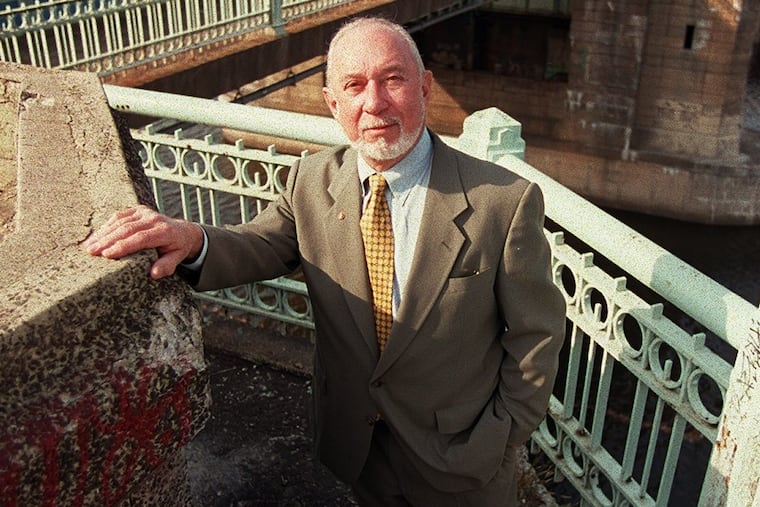Raymond Grenald, celebrated architectural lighting designer who first lit up Boathouse Row, has died at 96
He also illuminated the Liberty Bell Pavilion and the White House. His motto: Light has a distinctive effect on human behavior.

Raymond Grenald, 96, of Abington Township, pioneering and celebrated architectural lighting designer who set aglow the White House, Boathouse Row, Carlsbad Caverns National Park, and other local, national, and international locations, died Wednesday, March 6, of congestive heart failure at Rydal Park and Waters retirement center.
Trained as both an engineer and architect, Mr. Grenald added his own artistic sensibility regarding form and shadow to his intricate lighting designs. The resulting scenes, often arresting and memorable, became his professional signature.
He also studied psychology in college and said often that he sought to perceive the “totality” of a location as he reimagined its visual effect on the viewer. “I was interested in perception,” he told The Inquirer in 1999. “What architects created was not necessarily what people saw. I can determine that which is significant, and light it. That which I deem irrelevant I can erase by letting it disappear into darkness.”
He illuminated museums, universities, and hotels, and his most prominent lighting assignments were the president’s Oval Office, the stretch of Pennsylvania Avenue in Washington from the White House to the Capitol, and the Baltimore World Trade Center. Locally, he lit the Liberty Bell Pavilion, Independence Hall, Franklin Court, the University of Pennsylvania campus, seven bridges that span the Schuylkill, and many other public and private spaces.
Officials at the International Association of Lighting Designers said in an online tribute that Mr. Grenald “was instrumental in recognizing lighting design as a distinct creative field” and that “his legacy will continue illuminating the path for future generations of lighting designers.”
Boathouse Row is Mr. Grenald’s most notable project in Philadelphia. It debuted at dusk in October 1979 and immediately became one of the most recognizable cityscape scenes in the country.
That now-iconic nighttime image of a dozen boathouses all framed in light has been reproduced on countless prints, postcards, playing cards, T-shirts, and jigsaw puzzles. Mr. Grenald warned in a 1985 letter to The Inquirer’s editor that his original system needed to be updated, and it was for the third time on March 7, as 6,400 programmable LED lights glittered on the river, and hundreds of onlookers cheered.
Mr. Grenald used pole lights, flood lights, string lights, and fiber-optic lights in his designs, and former Mayor Ed Rendell told The Inquirer in 1999 that his creative lighting enhanced nearby businesses and spurred residential development. He worked on a home renovation in Center City in 1981, and an architecture critic said in The Inquirer: “One of the most sophisticated touches in the new house is its lighting.”
Unfulfilled as a aeronautical engineer at Boeing Co. in Seattle in the early 1950s, Mr. Grenald visited his sister in Philadelphia in 1955, liked the place, and went on to find plenty of work as an architect. He started his own firm in his garage in Elkins Park in 1968, grew it to become the prosperous Grenald Waldron Associates, and finally sold his share in 2000.
He cofounded and served as president of the International Association of Lighting Designers and was active with the American Institute of Architects, the Illuminating Engineering Society, and other organizations. He won awards, mentored many young designers, and his work was featured often in The Inquirer and Daily News.
» READ MORE: New programmable Boathouse Row lights go live: ‘A renewal of hope’ along the Schuylkill
He taught classes at Penn, Harvard University, and elsewhere, and retired around 2010. “He understood psychology as well as the aesthetic issue,” industrial designer Noel Mayo told The Inquirer in 1999, “so he always worked around the people first.”
Raymond Grenald was born Feb. 10, 1928, in Louisville. Ky. He was so smart that he made it through high school in two and a half years, and graduated at 16. He was drafted into the Army Air Corps in 1946 and survived a horrific airplane crash.
After his military discharge, he earned a bachelor’s degree in aeronautical engineering at Washington State University and a master’s degree in architecture at the University of Washington. He met Arlene Rubin, and they married in 1961, and had son Seth and daughter Bethany. After a divorce, he married Sis Kapnek in 1989, and they lived in Huntingdon Valley, and he welcomed her family into his.
Mr. Grenald enjoyed traveling, photography, and reading about history and mystery. He was inquisitive, kind, and a “wonderful storyteller,” friends said in an online tribute.
An Inquirer writer described him in 1999 as “an animated man who seems to have a new idea every minute.” His recent caregivers nicked him “the Energizer Bunny.”
“He had a great warmth to him,” his daughter said. “He really cared about people.” His son said: “He instilled in us a sense of compassion and a yearning for knowledge.”
In addition to his children, wife, and former wife, Mr. Grenald is survived by other relatives. A sister and a brother died earlier.
Services were held Sunday, March 10.
Donations in his name may be made to the International Association of Lighting Designers Education Trust, 242 N. York St., Suite 514, Elmhurst, Ill. 60126.